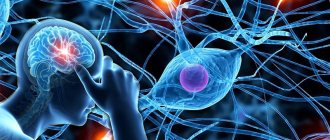Lhermitte-Duclos disease
Diagnosis of Lhermitte-Duclos disease is made by identifying characteristic formations in the cerebellum using computed tomography and magnetic resonance imaging. A CT scan of the brain reveals a volumetric hyperdense formation with blurred and indistinct edges, which can be located both on the surface and in the depths of the cerebellum. MRI of the brain is best performed with intravenous contrast, since this is the method that will best study the structure and vascular network of the tumor. In the absence of the technical ability to conduct these studies, X-ray ventriculography can be done - as a rule, it shows a decrease or displacement of the fourth ventricle and aqueduct. However, with a small size of gangliocytoma, such changes may not occur, so ventriculography is not considered the main method for diagnosing Lhermitte-Duclos disease.
In addition, if possible (for example, if the tumor is located superficial to the cerebellum), a biopsy of the formation is performed, followed by histological examination. Similar studies in recent years have revealed that cerebellar gangliocytoma in Lhermitte-Duclos disease is a hamartoma. In its structure, there is an expansion of the molecular layer and its filling with ganglion cells. Geneticists also sequence the PTEN gene sequence, which reveals the presence or absence of mutations in it. A study of hereditary history can also help in diagnosing Lhermitte-Duclos disease - in this case, it is worth paying attention to indirect signs of the disease, taking into account the possibility of an asymptomatic course. These include the presence of poly- and syndactyly, megalocephaly, and gingival hyperplasia in close relatives.
There is currently no specific treatment for Lhermitte-Duclos disease, but patients often undergo palliative surgery to remove cerebellar gangliocytoma. This is a technically difficult operation, since there is no clear boundary and transition layer between normal tissues and the hamartoma. In addition, in some cases, the tumor may be located deep in the cerebellum, making it inaccessible for complete removal. However, even partial resection of gangliocytoma can significantly alleviate the patient’s condition and prolong his life by several years. Other methods of combating tumors (for example, radiation therapy) for Lhermitte-Duclos disease are most often ineffective.
Treatment of multiple sclerosis
It is important to know that a 100% cure for sclerosis does not currently exist. Modern medicine can only reduce or slow down the harmful effects of the disease.
The treatment approach consists of three stages:
The main goals of treatment include:
Danger signs
Multiple sclerosis is a disease with numerous clinical manifestations of varying severity. Some of the main early symptoms are given below.
Article on the topic
“I’ll lie down and it will pass.”
What dangerous diseases do people often underestimate? 1. Visual impairment .
Vision problems are one of the most common symptoms of multiple sclerosis. The inflammation damages the optic nerve and impairs central vision. This can cause decreased or lost vision (central scotoma), blurred vision, and double vision. Visual impairment often occurs as the first and only symptom of multiple sclerosis. Since it is very specific for this disease and occurs quite often, special attention should be paid to it. 2. Sensitivity disorders . Multiple sclerosis damages the pathways in the brain and spinal cord responsible for transmitting the sensations of pain, temperature, tactile sensations, the sense of movement and position in space. Signals may not reach the brain or may be modified. Tingling sensations and numbness are among the most common signs of multiple sclerosis. Most often they occur in the face, arms, and legs. In addition, the appearance of “burning” and pain of various localization, impaired perception of cold, heat, and touch is possible.
3. Decreased strength in the limbs . Muscle weakness (paresis) in the arms and legs occurs due to a disruption in the propagation of excitation along the nerve fibers that transmit motor commands from the brain to the muscles. Weakness most often occurs in an arm and leg on one side or in the lower extremities. It is worth remembering that acute muscle weakness is a serious symptom of a neurological disease!
4. General weakness, increased fatigue . The complaint of unexplained fatigue is typical for 80% of people suffering from multiple sclerosis. Fatigue usually comes on suddenly and lasts for weeks before it improves.
5. Dizziness and imbalance . Dizziness occurs at rest or during movement, characterized by impaired accuracy of movements, instability when walking, and falls. Such complaints are associated with damage to the pathways coming from the vestibular nuclei and cerebellum.
6. Disruption of the normal functioning of the bladder . Bladder dysfunction affects up to 80% of people with multiple sclerosis. Symptoms include frequent urination, a strong urge to urinate, and episodes of leaking urine. Complaints associated with loss of control over bowel function are much less common.
7. Sexual dysfunction . Difficulty in sexual arousal is one of the manifestations of multiple sclerosis. The main centers responsible for the emergence and maintenance of libido are located in the brain, which is the main target of attacks of this disease.
Expensive. Difficult. Effective. How the treatment of autoimmune diseases has changed Read more
8. Cognitive problems . In approximately half of the cases with multiple sclerosis, higher mental functions are impaired, which is manifested by symptoms such as decreased memory and attention, difficulties in performing mental tasks and planning one’s activities.
9. Emotional disorders . Depressive disorder is very common among people with multiple sclerosis. There are complaints of increased irritability, mood swings, causeless agitation or apathy. If there are numerous foci of demyelination in the cerebral hemispheres, attacks of uncontrollable crying and/or laughter may occur.
10. Trigeminal neuralgia . Characterized by attacks of intense throbbing pain in half of the face.
11. Facial nerve neuropathy . Characterized by the appearance of unilateral weakness in the facial muscles. On the affected side, it is difficult for a person to wrinkle his forehead, completely close his eye, smile and tense his chin muscles.
12. Speech and swallowing disorders . One of the symptoms of multiple sclerosis may be blurred speech, pronouncing words through the nose (nasality), and choking when swallowing food.
The symptoms of multiple sclerosis are numerous and varied, but most of them are characterized by the fact that they develop quickly and can also disappear suddenly, especially at the beginning (onset) of the disease.
It is also important to know that multiple sclerosis most often affects young women with the onset of the disease at the age of 20-40 years. After 60 years, this disease almost never occurs (most of the above complaints in older people are associated with vascular damage to the brain).







